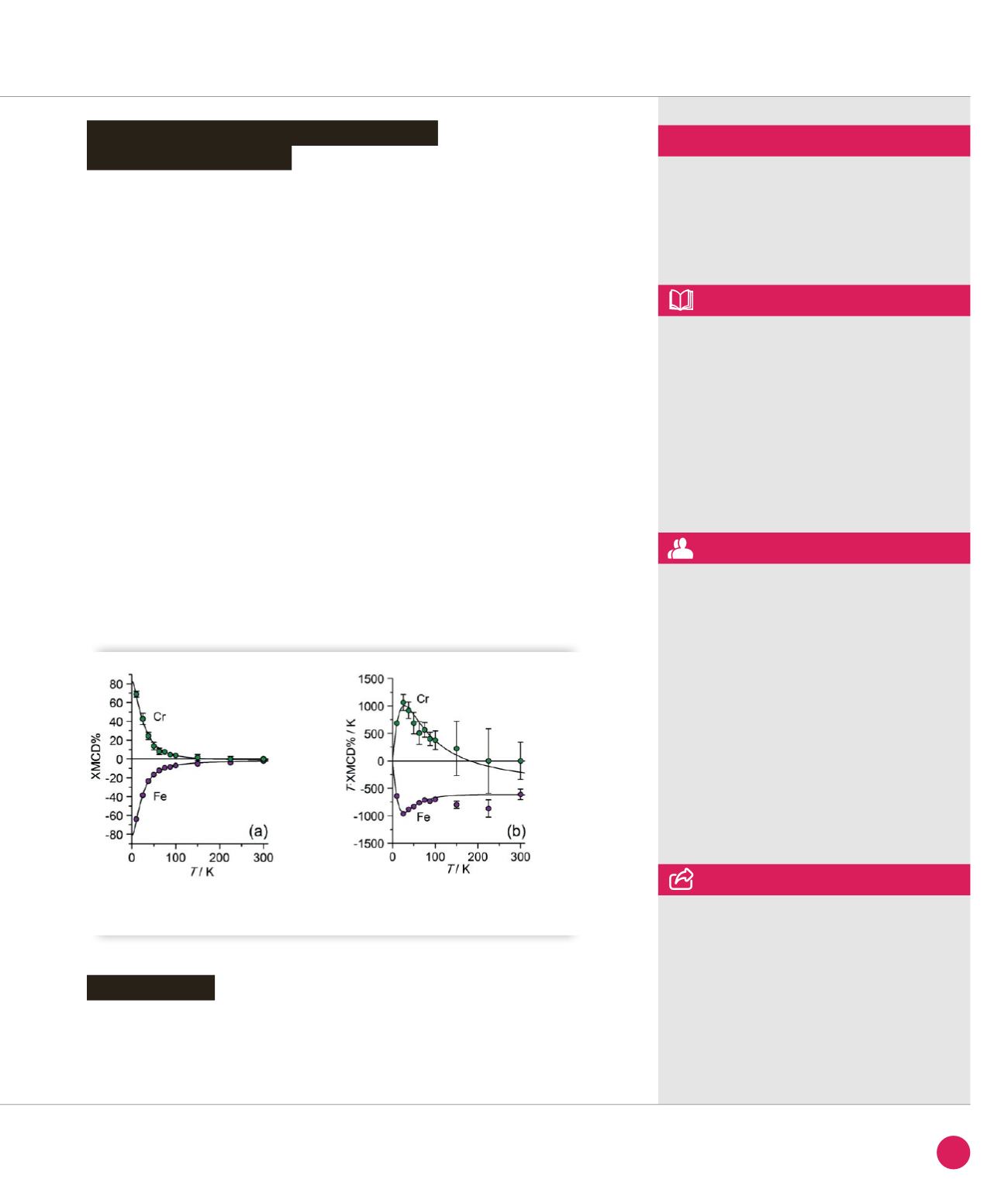
We have now evidence that tetrametallic
SMMs deposited on Au(111) retain a
bulk-like electronic structure over the
energy scale defined by superexchange
interactions. To separately probe the
magnetism of the central and peripheral
ions, the central iron(III) was selectively
replaced by a chromium(III) ion (
s
= 3/2)
(Figure
➊
b
). The Fe
3
Cr complex so
obtained is otherwise structurally identical
to the corresponding Fe
4
species and
still entails an AF Fe-Cr coupling (
J
Fe-Cr
).
Bulk-phase samples and monolayers
on Au(111) were analyzed by XMCD at
Fe and Cr L
3
edges. Signals of expectedly
opposite sign were observed at
T
values
(10 K) where the ground state is
predominantly populated (Figure
➋
).
With increasing
T
, the XMCD% signals
were found to undergo a rapid decrease
in amplitude while maintaining the
same profile (Figures
➋
and
➌
a
). The
T
dependence of magnetic polarization
was however best appreciated by plotting
XMCD%·
T
vs.
T
data, as commonplace in
traditional magnetometry. As shown
in Figure
➌
b
, pronounced deviations from
Curie law were detected below 100 K.
Data analysis was based on a Heisenberg
plus
Zeeman hamiltonian (
J
S
1·
S
2
convention), since in the explored
T
range
magnetic anisotropy has no effect
on magnetic behaviour.
Simultaneous fitting of the two curves
gave
J
Fe-Cr
= 14.7(7) cm
-1
, in excellent
agreement with the value found in the
bulk phase by the same method as well as
by SQUID magnetometry. It is noteworthy
that magnetic polarizations at Fe and Cr
centers exhibit different
T
dependences,
in full agreement with a Cr-centered Fe
3
Cr
topology. In fact, in Fe
3
Cr systems the
magnetic polarization at Fe sites is always
parallel to the applied field. By contrast,
polarization at the Cr site must switch from
field antiparallel to field parallel around
180 K, as thermal energy overcomes AF
interactions. At this
T
, however, the XMCD
signal at the Cr L
3
edge is already zero
within experimental error.
Our findings show that the interaction
with a gold surface fully preserves
the spin structure of Fe
3
Cr complexes.
Superexchange interactions, as
determined by variable-
T
XMCD, compare
well with bulk-phase values in both sign
and strength, a rare situation for surface-
supported polynuclear architectures [5].
ON-SURFACE TEMPERATURE-DEPENDENT
XMCD MAGNETOMETRY
CONCLUSIONS
DEIMOS beamline
ASSOCIATED PUBLICATION
On-surface magnetometry: the evaluation
of superexchange coupling constants
in surface-wired single-molecule magnets
E. Tancini, M. Mannini, Ph. Sainctavit,
E. Otero, R. Sessoli, and A. Cornia*
Chemistry - A European Journal 19(50) (2013),
16902
REFERENCES
[1] J. D. Rinehart et al. J. Am. Chem. Soc.
133 (2011), 14236
[2] M. Misiorny et al. Phys. Rev. Lett.
111 (2013), 046603
[3] M. Mannini et al. Nat. Mater. 8 (2009), 194
[4] M. Mannini et al. Nature 468 (2010), 417.
[5] V. Corradini et al. Adv. Mater. 25 (2013), 2816
*Dipartimento di Scienze Chimiche e
Geologiche & UdR INSTM, Università di
Modena e Reggio Emilia, via G. Campi 183,
41125 Modena, Italy
CORRESPONDING AUTHOR
❸
T
-dependent XMCD signal at 709.1 eV (Fe) and 577.5 eV (Cr) recorded on a monolayer of Fe
3
Cr on Au(111) in
a 50 kOe applied field (normalization carried out as described in the caption to Figure
➋
). Error bars have been
omitted when smaller than the symbol size. Solid lines represent best-fit calculated curves with
J
Fe-Cr
= 14.7 cm
-1
.
45
SYNCHROTRON
HIGHLIGHTS
2013


